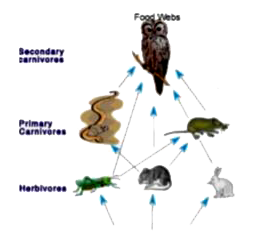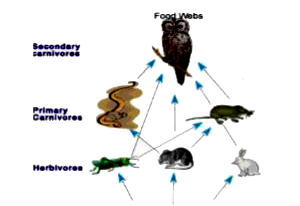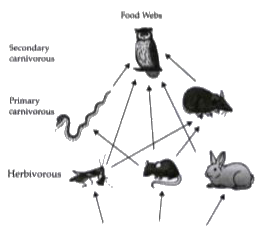Food chains are very important for the survival of most species

If 10,000 J solar energy falls on green plants in a terrestrial ecosystem, what percentage of solar energy will be converted into food energy?
10,000J
100J
1000J
It will depend on the type of the terrestrial plant
The correct Answer is:B
100J
Topper's Solved these Questions
- QUESTION BANK 2021BOOK - CBSE MODEL PAPERCHAPTER - QUESTION BANK 2021EXERCISE - PROBABILITY (Case Study 2)
5 Videos
- PRACTICE PAPER 2022BOOK - CBSE MODEL PAPERCHAPTER - PRACTICE PAPER 2022EXERCISE - Multiple Choice Questions
60 Videos
- SAMPLE PAPER (MATHEMATICS STANDARD)BOOK - CBSE MODEL PAPERCHAPTER - SAMPLE PAPER (MATHEMATICS STANDARD)EXERCISE - PART - B
16 Videos
Similar Questions
Food chains are very important for the survival of most species. When only one element is removed from the food chain it can result in extinction of a species in some cases. The foundation of the food chain consists of primary producers
Primary producers, or autotrophs, can use either solar energy or chemical energy to create complex organic compounds, whereas species at higher trophic levels cannot and so must consume producers or other life that itself consumes producers. Because the sun's light is necessary for photosynthesis, most life could not exist if the sun disappeared. Even so, it has recently been discovered that there are some forms of life, chemotrophs, that appear to gain all their metabolic energy from chemosythesis driven by hydrothermal vents, thus showing that some life may not require solar energy to thrive.

If 10,000 J solar energy falls on green plants in a terrestrial ecosystem, what percentage of solar energy will be converted into food energy?
View SolutionFood chains are very important for the survival of most species

Matter and energy are two fundamental inputs of an ecosystem. Movement of
View Solution
Knowledge Check
Food chains are very important survival of most species.

Matter and energy are two fundamental inputs of an ecosystem. Movement ofAEnergy is bidirectionaland matter is repeatedly circulatingBEnergy is repeatedly circulation and matter is unidirectional.CEnergy is unidirectional and matter is repeatedly circulatingDEnergy is multidirectional and matter is bidirectional.What percent of solar energy is absorbed by terrestrial ecosystem?
A0.02B0.1%C0.5%D4.1%The green plants in a terrestrial ecosystem capture about .......... of the energy of sunlight.
A4%B2%C1%D3%
Food chains are very important for the survival of most species

Which of the following limits the number of trophic levels in a food chain?
View SolutionThe green plants in a terrestrial ecosystem capture about 1% of the energy of sunglisht . Is it ture ?
View SolutionWhat is the percentage of solar energy trapped and utilised?
View SolutionWhat is the percentage of solar energy trapped and utilised?
View SolutionWhat percent of solar energy is absorbed by the terrestrial ecosystem?
View Solution
